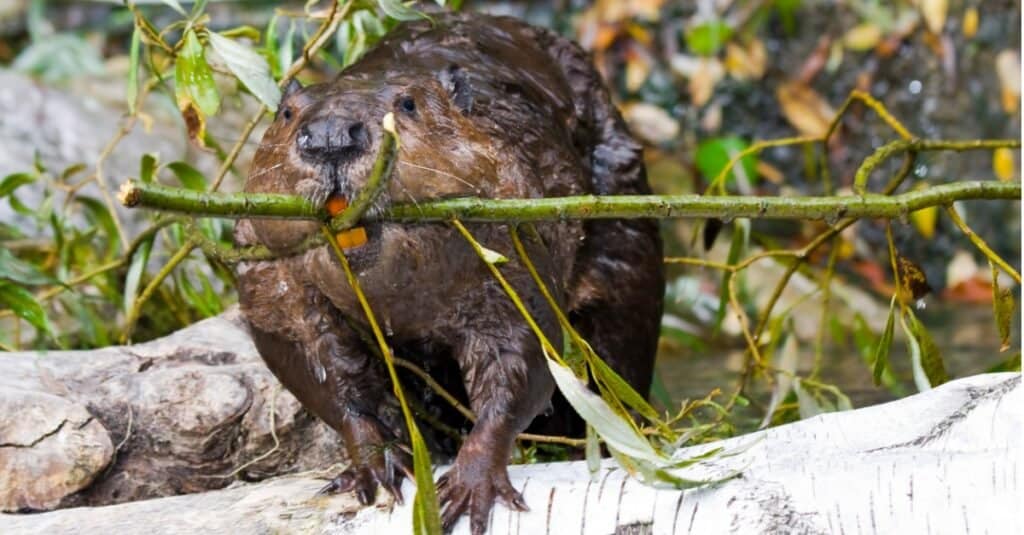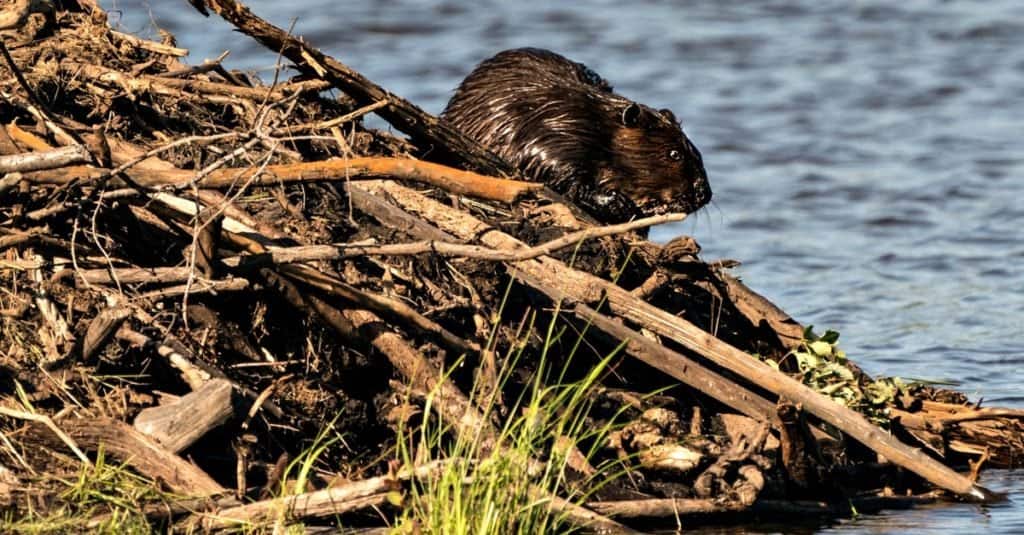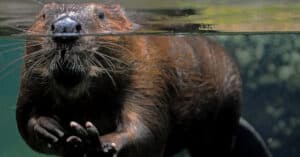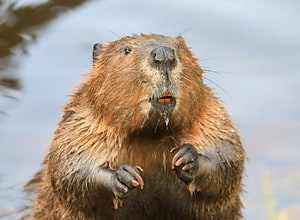Like humans, beavers change their environments to meet their needs. As “nature’s engineers,” they are highly intelligent creatures and excellent swimmers, traveling five miles per hour. They may be slow-moving and graceless on land, but they are sleek when they swim, so they choose to surround themselves with water. This chubby lumberjack can find plenty of suitable aquatic habitats in the Lone Star State. Discover where beavers in Texas live and whether they are dangerous or a nuisance.
About Beavers in Texas

Beavers are the second largest rodent on earth.
©Groucho M, Public domain, via Wikimedia Commons – License
Beavers are the second largest rodents on earth and the descendants of an 800-pound giant rodent from millions of years ago. But today, they weigh no more than 60 pounds and are thoroughly adapted to their aquatic lifestyle. They have rotund bodies, large heads, long teeth, and brown or gray fur. Beavers have hand-like front feet and webbed back feet with paddle-like tails.
They use their toenails as combs for frequent grooming, and you can often see them perched on their tails near the water’s edge as they perform their beauty rituals. The beaver produces a strong-smelling oil located in glands at the base of its paddle tail; it uses its nails to scoop it out and rubs it over its thick fur, making it waterproof.
Beavers have strong skills in regulating water levels and stream flows, building the infamous dams that make areas habitable for them. They create “beaver lodges” where they stop a river’s flow to create a pond that provides them protection from predators. The deep water from these pools makes them feel safe and secure.
These creatures often have to start the building process over due to sediment settling in their ponds and creating meadows, forcing them to relocate. Large rivers and lakes offer plenty of food and den options, but most beavers in Texas prefer small bodies of water. When it’s chilly outside, they will make burrows in the cut banks of streams and lakes. There is evidence of these holes in the Big Bend region.
What Do Texas Beavers Eat?

Beavers in Texas eat leaves, twigs, and inner bark.
©iStock.com/belizar73
Beavers are herbivores, primarily feeding on leaves, twigs, and bark. Their favorite food is the inner bark of cottonwoods and willows, but they will settle for what’s available in their geographic area. For instance, Central Texas lacks willow trees, so beavers resort to eating bark from the buttonwillow, juniper, and pecan trees.
During summer, they expand their food range and feast on aquatic plants, sedges, grasses, ragweeds, and water lilies. In the Rio Grande Texas region, you can find them feeding off mesquite and tobacco, consuming what’s readily available in its environment.
Where Do Beavers Live in Texas?

Beavers live in most areas throughout Texas with suitable aquatic habitats.
©Rejean Bedard/Shutterstock.com
Beavers inhabit most areas throughout Texas; the Panhandle, the entire Eastern half, along the Mexican border, and the very most southern tip. You can find them relatively anywhere there are suitable aquatic habitats. However, they are absent from the Llano Estacado and most of the Trans-Pecos region.
Unlike its northern cousins, the Texas beaver can quickly move around most of the winter, especially those inhabiting southern regions. Even though the water surface rarely freezes, the beaver will gather and store a stockpile of twigs and branches under the water (just in case). You will find these giant rodents along rivers, lakes, and streams in Texas. Their highest population is in the northeastern part of the state. In fact, east Texas’ swamps and wetlands wouldn’t exist without beavers.
How Many Beavers Are in Texas?
Beavers almost became extinct due to the 200-year fur trapping crusade. But their success story is quite inspiring. In 1950, the state began reintroducing beavers into their natural habitats, and their population exploded. Today there are more beavers in Texas than there have ever been.
There are well over 100,000 beavers in Texas, which is a low estimate. They now protect the wetland habitats essential to the survival of many threatened and endangered species, such as the Southwestern willow flycatcher, the Western yellow-billed cuckoo, and the Houston toad. Beavers are essential to the ecosystem and the habitat they create. Without the beaver, these wetlands, swamps, and marshes may disappear. Thankfully, their numbers are multiplying. But with the increase in beavers comes an increase in costs and other issues that plague the state.
Are Beavers Dangerous?

Beaver attacks on humans are extremely rare, but they will defend themselves if necessary.
©U. Eisenlohr/Shutterstock.com
Beaver attacks on humans are extremely rare, but like any wild animal, they will defend themselves when threatened or backed into a corner. They can be highly aggressive when defending their territory or handling a perceived threat and will lash out and bite. Its sharp front teeth have a 180-pound bite force and can cause severe damage and infection.
Only one fatal human attack was recorded. A 60-year-old fisherman died after a beaver severed the main artery in his leg. Beavers also carry tularemia, parasites, and rabies, which humans can contract through bites and bodily fluids (possibly contaminated water).
Do Beavers Cause Damage?
Beavers cause $2.5 million in annual damages in Texas. When beavers hear running water, they instinctively build a dam to stop its flow. Culverts, or tunnels carrying a stream under a road or railroad, occasionally have water rushing through their pipes. When beavers hear this, they patch it up, which causes flooded roadways and potentially damages nearby crops. These creatures also gnaw on trees and crops, damaging them, and they can degrade and destabilize banks and levees.
Up Next:
The photo featured at the top of this post is © iStock.com/CreativeNature_nl
Thank you for reading! Have some feedback for us? Contact the AZ Animals editorial team.






